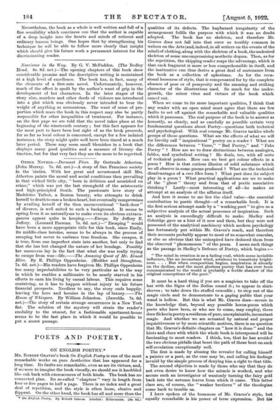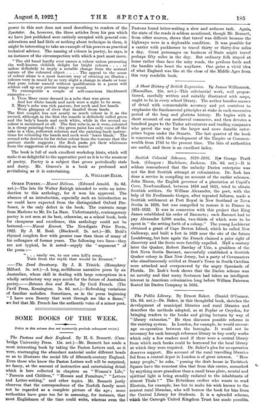POETS AND POETRY.
ON ENGLISH POETRY.*
Mn. ROBERT GRAVES'S book On English Poetry is one of the most remarkable works on pure Aesthetics that has appeared for a long time. Its faults are remarkable, even as are its virtues, and, if we were to imagine the book visually, we should see it knobbled like oak bark with excrescences of both kinds. The book has no connected plan. Its so-called " chapters " vary in length from four or five pages to half a page. There is no index and a great deal of repetition, and the style is often loose, elusive and flippant. On the other hand, the book has all and more than the • On English Poetry. By Robert Omni. London: Heinemann. Va. Odj
qualities of its defects. The haphazard irregularity of the arrangement fulfils the purpose with which it was no doubt adopted. The book has no skeleton, and therefore Mr.
Graves does not fall into that error so terribly common in writers on the Arts (and, indeed, in all writers on the events of the mind) of clothing, along with the skeleton of a book, the undesired skeleton of some uncompromising aesthetic dogma. Then, as for the repetition, the skipping reader reaps the advantage, which is that each fragment is more or less comprehensible in itself, and the inattentive can thus derive a great deal of sustenance from the book as a collection of aphorisms. As for the occa- sional looseness of style, that is compensated for by the complete absence of pose or of pomposity and the amusing and striking character of the illustrations used. So much for the under- growth, the minor vices and virtues of the book which cancel out.
When we come to its more important qualities, I think that
any reader with an open mind must agree that there are few faults to set off against the remarkable and valuable qualities which it possesses. The real purpose of the book is to answer as honestly, as clearly, and as carefully as possible certain very fundamental questions about Poetry—questions both technical and psychological. With real courage Mr. Graves tackles whole groups of these questions. What are the effects of what we will for brevity call " inspirational " poetry on a reader ? What are the differences between "Verse," "Bad Poetry," and "Fake Poetry " ? How are we to draw distinctions between analogies, fables, and symbolical writing ? He deals, too, with all sorts of technical points. How can we best get colour effects in a poem ? How is that curious illusion of solid substance which
we all observe in some poems produced ? What are the technical disadvantages of a rens libre form ? What part does its subject
play in a poem ? What practical applications are we to make of the " ghost " theory and from that of poetic associative thinking ? Lastly—most interesting of all—he makes an attempt at an analysis of the afflatus itself.
And here it seems to me lies the chief value—the essential contribution to poetic thought—of a remarkable book. It is the first serious attempt made by a "working poet" to give us a subjective analysis of the actual processes of inspiration. Such an analysis is exceedingly difficult to make. Shelley and Coleridge gave us a hint of it now and then, but they were not possessed of the analytical machinery which modern psychology
has fortunately put within Mr. Graves's reach, and therefore their accounts probably appear to most of UR somewhat oracular, or else so obvious that the uninspired have deduced them from the observed " phenomenon " of the poem. I mean such things as the passage in Shelley's Defence of Poetry, which begins :— "The mind in creation is as a fading coal, which some invisible influence, like an inconstant wind, awakens to transitory bright- ness. . . . But when composition begins, inspiration is already on the decline, and the most glorious poetry that has ever been communicated to the world is probably a feeble shadow of the original conceptions of the poet.'
It must be a hard thing if you are a magician to take off the hat with the Signs of the Zodiac round it ; to appear in shirt- sleeves ; to take down the stuffed crocodile ; to step out of the magic circle and to demonstrate to a gaping public that your
wand is hollow. But this is what Mr. Graves does—secure in the knowledge that, beyond any possible hocus-pocus which poets who have been, or who are to come, may employ, there does fficker in poetry a residuum of pure, unexplainable, inconstant magic. And whether we are actuated by natural and proper inquisitiveness or by more scientific motives, there is no question that Mr. Graves's definite chapters on "how it is done" and the hints and clues with which the whole book is interspersed will be fascinating to most readers. I think, too, that he has avoided the two obvious pitfalls that beset the path of those bent on such self-revelation exceptionally well.
The first is made by abusing the revealer for calling himself a painter or a poet, as the case may be, and calling his findings invalid by the simple process of denying him a right to that title.
The second objection is made by those who say that they do not even desire to know how the miracle is worked, and who accuse such an investigator of wantonly turning the fairy gold back into the autumn leaves from which it came. This latter class are, of course, the "weaker brethren" of the theologian come back to trouble us.
I have spoken of the looseness of Mr. Graves's style, but equally remarkable is his power of terse expression. But his power in this sort does not need describing to readers of the Spectator. As, however, the three articles from his pen which we have just published were entirely occupied with general con- siderations and had little or nothing about technique in them, it might be interesting to take an example of his powers as practical technical adviser. The naming of colours in poetry, he says, is an instance of the circumspection with which a poet must move.
"The old hand hardly ever names a colour unless presenting the well-known childish delight for bright colours . . . . or unless definitely to imply a notable change from the normal nature of the coloured object . . . . The appeal to the sense of colour alone is a most insecure way of creating an illusion ; colours vary in mood by so very slight a change in shade or tone that pure colour named without qualification in a poem will seldom call up any precise image or mood.
To extemporize a couple of self-conscious blackboard examples :- 1. Then Mary came dressed in a robe that was green And her white hands and neck were a sight to be seen.
2. Mary's robe was rich pasture, her neck and her hands Were glimpses of river that dazzled those lands. The first couplet has not nearly so much colour in it as the second, although in the first the mantle is definitely called green and the lady's hands and neck white, while in the second no colour is mentioned at all. The first robe is, as it were, coloured in a cheap painting-book ; the green paint has only come off the cake in a thin, yellowish solution and the painting-book instruc- tions for colouring the hands and neck were 'leave blank.' The second robe derives its far richer colour from the texture that the pasture simile suggests ; the flesh parts get their whiteness from the suggestion of sun shining on water."
The book is full of such excellent workshop hints, which will make it as delightful to the apprentice poet as it is to the amateur of poetry. Poetry is a subject that grows periodically stale and dusty. Mr. Graves's is a book as profound and revitalizing as it is entertaining.
A. Wrumurs-Euss.



































 Previous page
Previous page